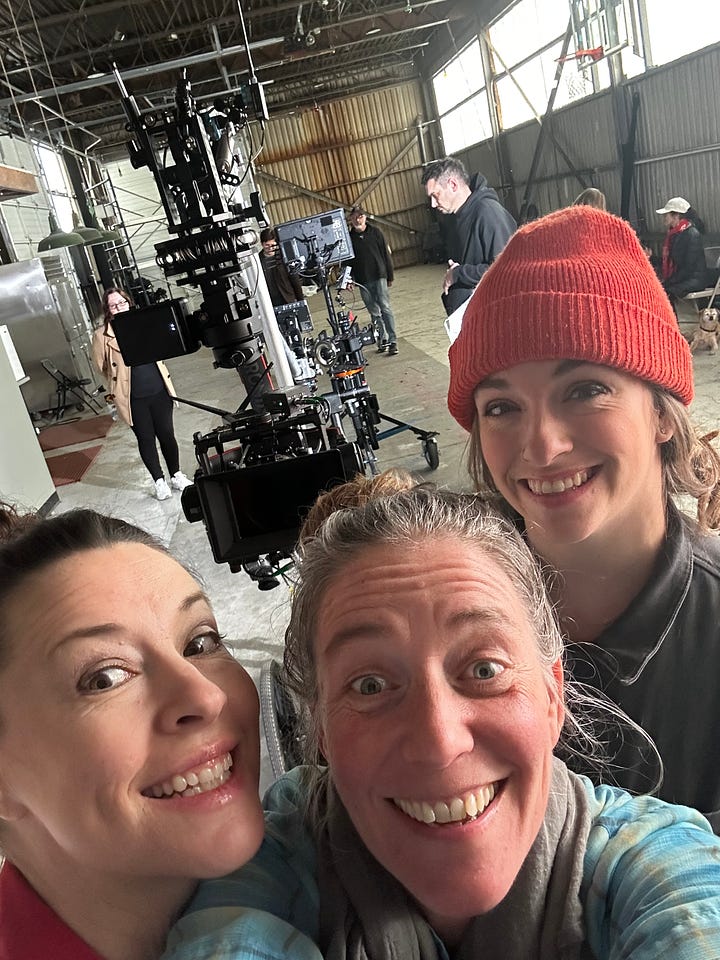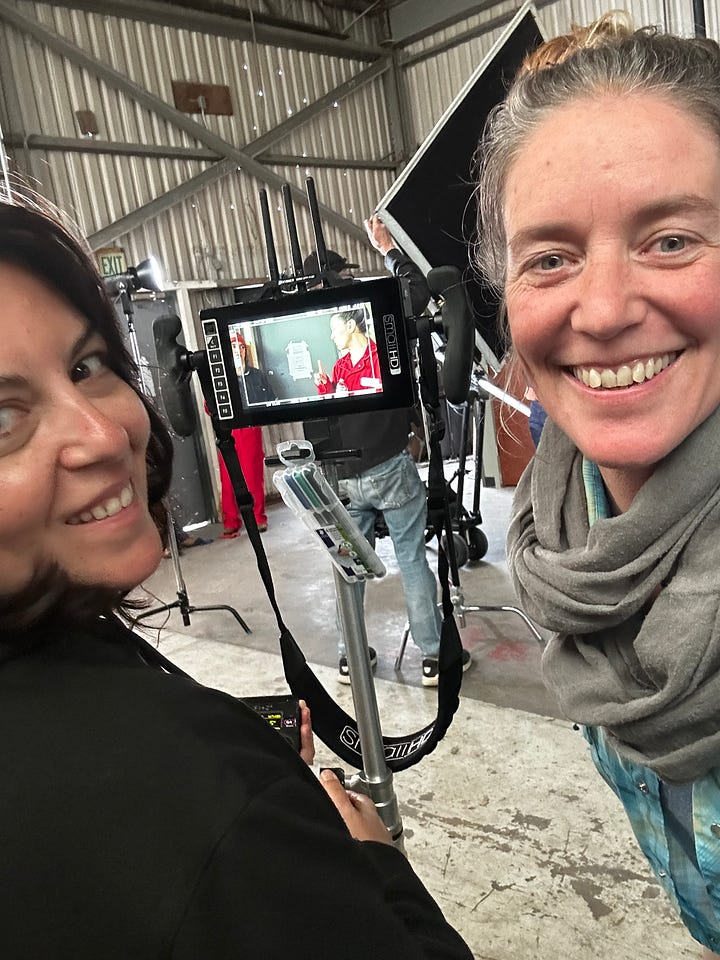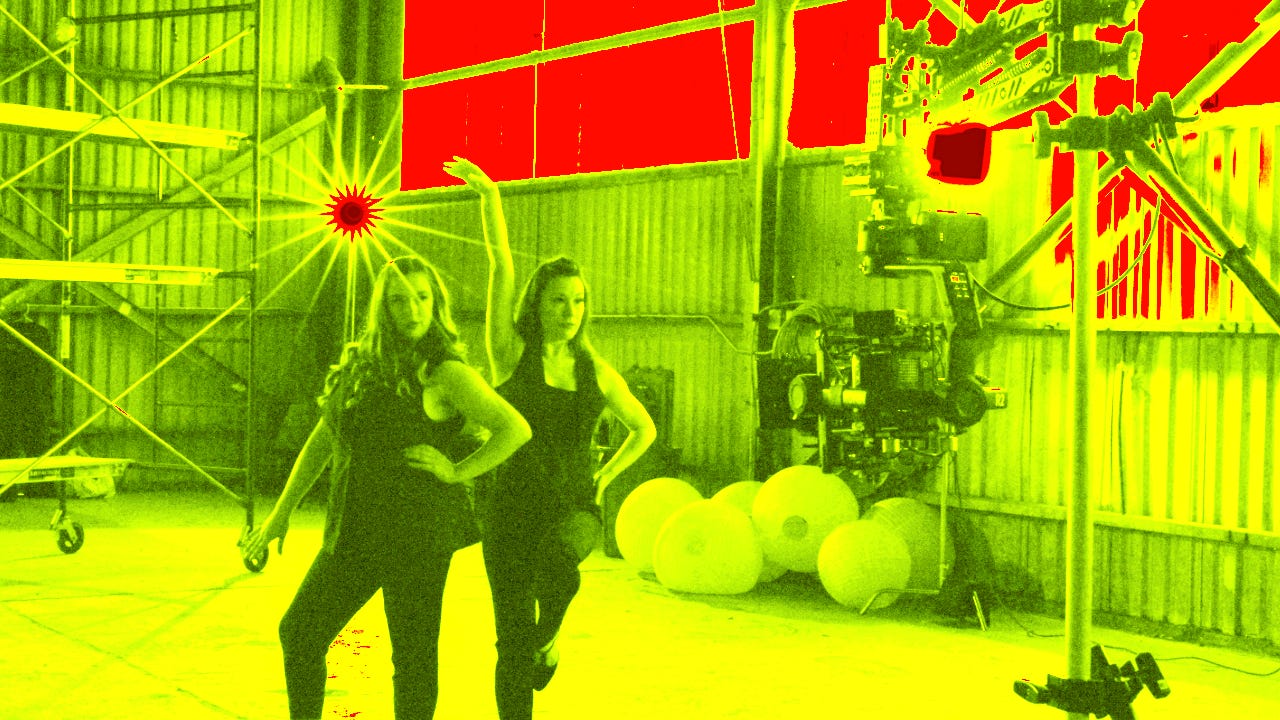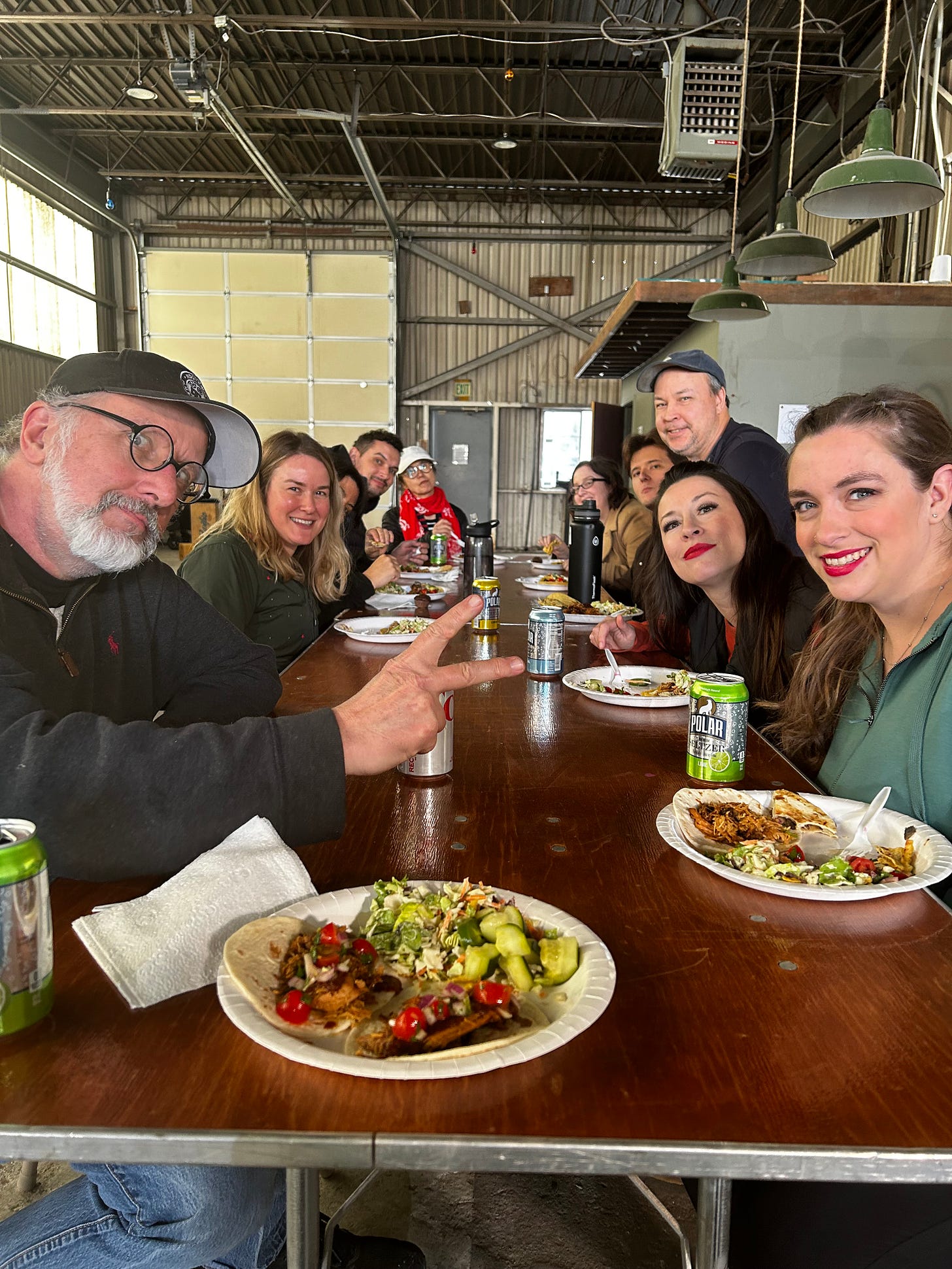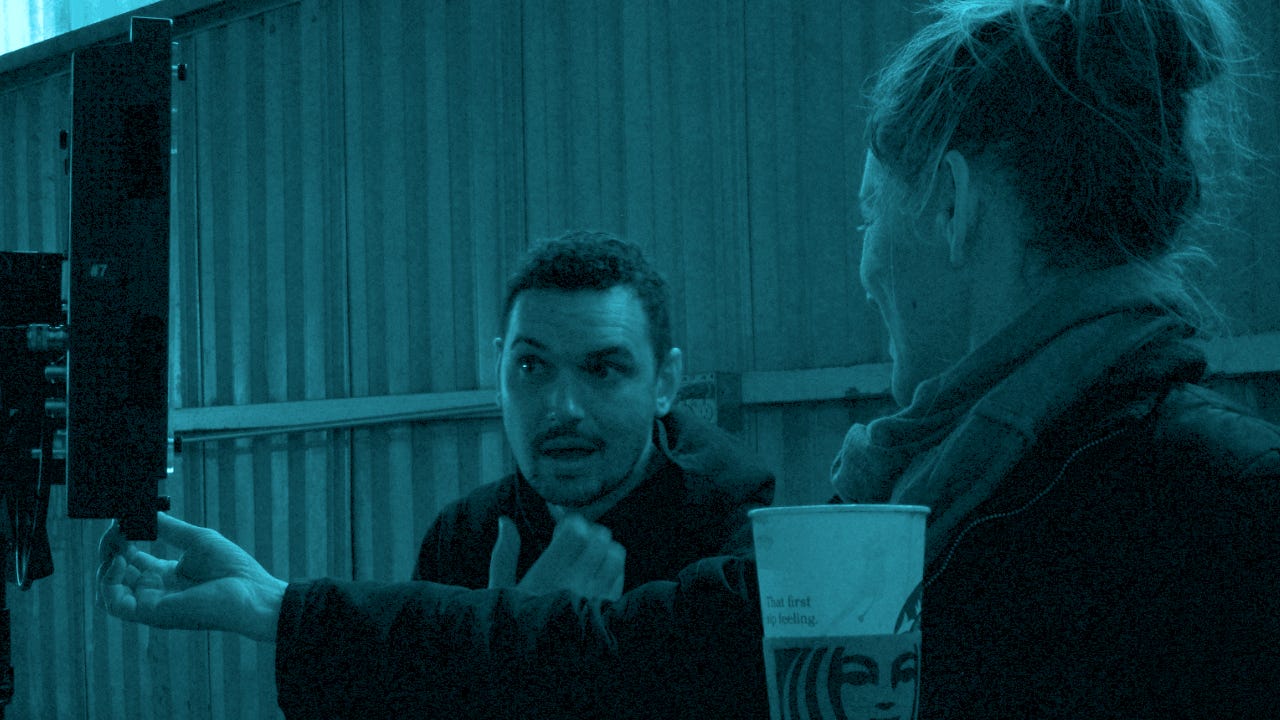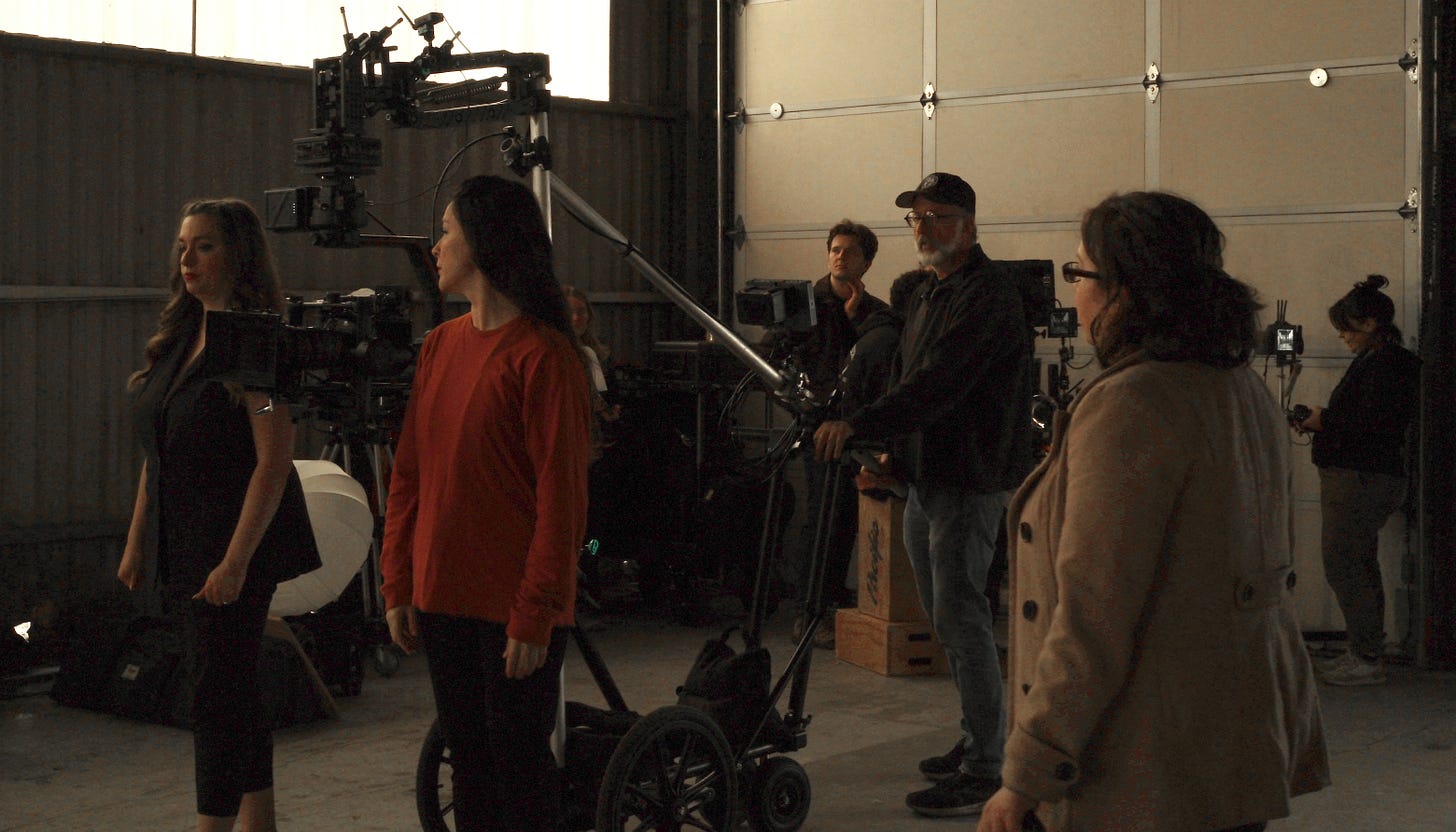Let the pan and the tilt into your heart.
Seattle Cinematography Workshop # 1
April 21st 2024 “Dream on Set”
I will begin this post with the chronicles of the first Seattle Cinematography Workshop. I hope it helps you understand what the Seattle Cinematography Workshop substack is all about, learning with us.
I will start with the director’s journal.
Once upon a time, on April 21st, I was the director mentee of the SCW shoot in a warehouse in South Park.
Every shoot has a crew. On April 21st we had one day to shoot a short script/storyboard. We consisted of crew mentees, and crew mentors. Mentees are aspiring filmmakers at varied levels of experience. Mentors come aboard as professional counterparts to shadow and teach the mentee crew. Each shoot is a new script, and a new crew. This allows working professionals a chance to help when they can. The story of crew-building for the inaugural shoot deserves its post. I’ll include it in a producer’s account.
Since this is a new, grassroots program, we only fill the departments crucial to photography. There is no sound, for example. And no art department. This leaves the director with many roles to fill herself. At every shoot, the director’s job is to view the location ahead of time and create or acquire a 2-3 page script that works with it. She then finds the talent, the set, and props. It’s a big job, and a massive learning opportunity.
To give you a picture of the crew that Sunday, here is the crew list:
Production: myself, Producer/Coordinator, and Director Mentee; Maria Gargiulo, Director Mentor; Umberto Lenzi, 1stAssistant Director Mentee; Severin Wiggenhorn, Script Supervisor Mentee
Camera: Evan Olson, Director of Photography Mentee; Theo Angell, Director of Photography Mentor; Chris Duerkopp, Camera Operator and Mentor; Martina Coccia, 1st Assistant Camera Mentee, Lili DeBarbieri, 2nd Assistant Camera Mentee
Electric (Lighting): no crew, mentors assisted
Grip (Everything!): no crew, mentors assisted
101 LESSONS LEARNED ON THE SCW SET
I chronicle my story as the first Director Mentee in the hope that it is the first of many lessons written down in this blog, from as many SCW participants as I can coax into sharing. In my writing, my account shifts unceremoniously between first and second-person narrative. I am always talking to myself, and you. Please read it as if I am with you in the same room, with fellow directors, new ones. As I share lessons with you, I remind myself…here it goes
…
Lesson ONE.
1. Believe monitor settings. Prior to each shot, always check that the monitor settings are correct, especially after anything is unhooked from the camera, like lenses or monitors.
a. Know what the settings are supposed to be. That was my first mistake. I honestly had no idea.
b. The monitor settings are accurate. When it reads “19:6 1080p” it is not telling you the monitor capability-- that reading is providing you with camera setting information.
APRIL 21st, 9:00 am. SCW Load In. In order to mount the camera on the rickshaw dolly, the camera operator mentor and his crew set up the camera, they unhooked something – a monitor? Please allow me to tell you how we arrived here, at lesson #1, with this cinema camera on a rickshaw.
SCW receives the support of Koerner Camera Supply in Fremont. With encouragement from the manager, the DPs submitted a “shoot for the moon” equipment list. They chose an Arri Alexa Mini cinema camera. According to the 1st Assistant Camera on this shoot, Martina, the Alexa is the go-to choice for movie-making. As new filmmakers, this was a rare opportunity to shoot with it.
To qualify for this rental, camera crew mentees attended a camera training on April 16th and a prep on April 19th. At the prep, DPs set the camera to the proper settings for this specific shoot—open gate in 4K. An open gate camera setting means that the camera shoots and records the image (or data) onto the entire sensor, filling it. A sensor is the digital equal to the film roll in an analog camera. It is the object that receives and saves the image(s). An open gate setting gives the director lots of choices in post production, where editing and colorizing takes place. Since we planned to shoot a music/dance video, the more artistic options available, the better. I liked this open gate idea. 4K means lots of digital data is available. Many DSLR cameras can do it, but not with the results of an Alexa. As the director mentee, I supportively deferred these setting choices to the DPs. I hope they felt supported; perhaps my cluelessness is not exactly the same as support. Sigh. I am learning….!
These cinema cameras have two types of batteries, external and internal. When the external battery runs low on set, the crew exchanges them with a full battery. This happens regularly on a shoot. The internal battery, however, is rarely low, almost never dies. But sometimes it does. I am a bit unclear as to exactly what happened; nevertheless, the internal battery died, and the camera reset to default settings. So instead of shooting open gate in 4K, we shot 19:6 (cinema format) in 1080p. All day long.
Oops. Good thing this is an experimental, low-pressure workshop! Otherwise, I think this is what insurance is for, as this error might have required a reshoot of the day to match footage. But, on a professional shoot, attention would also have been on a different level. I was and still feel surprisingly chill about this error, because I am very happy to have gained this knowledge about the importance of settings.
Why did the monitor have to be disconnected by the camera operator?
Originally, we had a Trinity Steadicam Operator booked to mentor with us. This was a dream come true for me. I wanted to shoot fluid masters (roughly speaking), shots covering the long pieces of choreography with lots of camera movement. This rig and operator could easily achieve this goal. A rather new invention, A Trinity rig has been used, most notably in 1917 by the Deakins DP crew, to help portray a one-shot movie (1917 wasn’t, but it looked like it) from the intimate perspective of a soldier racing against time to save his brother’s troop. Plus, I thought maybe I am to be a Trinity Op when I grow up…? As a retired dancer who wants to dance behind the camera, it seems like a possible occupation.
A Trinity rig gives lots of options to pedestal. A “pedestal” is a vertical camera lift or lowering that follows the actor’s body--up the body, or down it. I heard a feature film director on the podcast, Smartless, say, “don’t pan, always dolly”. After seeing Speilberg’s West Side Story, I fully supported this advice. Speilberg used lots and lots of pans. It looked terrible [in my brazenly humble opinion]. I planned to avoid tilts and pans all together.
Smartness Episode with Barry Sonnefeld “…never pan, always track”
Anyway, our lovely #train-it-forward-supportive Trinity operator had to drop out. He got a gig. So Chris stepped in immediately. A Steadicam operator with fourteen years of experience, he spent so much time with us—the previous Saturday at camera rehearsal, Friday at camera prep, AND all day Sunday on set. As cool as a cucumber, as kind as kind as can be, not only did he donate his services, he donated his equipment. From shooting features, to us. We were so blessed to have him.
Originally, Chris offered to use his Steadicam unit. A Steadicam is different from a Trinity because it holds the camera closer to the operator’s body, allowing about eighteen inches of vertical movement per shot, instead of the Trinity’s full body vertical moving ability. Chris suggested that I schedule the shots in order of height. A shot schedule is the order of shot production. The height-change process eats up fifteen minutes of precious shooting time, so we took his advice and scheduled the shots, low to high coverage: heels to knees, knee to torso, and waist to head, and in that order. Wednesday evening, four days prior to the shoot, the lead team received an email from Chris. He sprained his ankle. So we switched from Steadicam to Rickshaw Dolly
.
In retrospect, I cannot think of a better start to a director’s training. These real situations create more learning opportunities than academic study, no doubt about it. Don’t get me wrong, I love academia and have two performance degrees to prove it. But this is the place for serious integration at a make-it-happen pace!
But, at the time, I experienced the overwhelm. I had no idea how to adjust to a rig I had never seen before. After semi-panicked email exchanges with Chris, where he explained that now we had about ten inches of vertical movement available, I knew what I had to do. Just roll with it. Let go. Let the pan and the tilt into your heart. Meh.
I have circled back, back to the Rickshaw dolly, and why did the crew disconnect the monitor? Answer: In order to set up for the first shot of the day—a low level at the dancer’s feet—the rickshaw arm had to be adjusted, which involved disconnecting the monitor. [Please note: These technical details are wrong, most likely. I don’t know exactly what was changed on the rickshaw or the monitor. Please watch for subscriber comments that clarify details. And feel free to join in with your own comment]
Thanks for reading. Please share your thoughts. And stay tuned…
